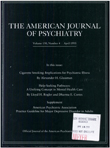Screening for dysfunction in the children of outpatients at a psychopharmacology clinic
Abstract
OBJECTIVE: The goals of this study were 1) to determine whether the use of the Pediatric Symptom Checklist in an adult-oriented psychiatric practice was feasible, 2) to determine if scores indicative of dysfunction on the Pediatric Symptom Checklist were associated with parental or background factors, 3) to determine whether children flagged by their scores on the Pediatric Symptom Checklist were receiving psychiatric services, and 4) to compare the psychosocial dysfunction in this group of children with that found in children screened as part of routine pediatric visits. METHOD: Adult outpatients in a hospital's clinical psychopharmacology unit were asked to complete the Pediatric Symptom Checklist regarding their children. These patients were the parents of 100 school-aged children. Factors such as the parents' diagnoses and demographic variables were also examined. RESULTS: The Pediatric Symptom Checklist was readily accepted by parents and fit easily into the routine of general psychiatric practice. Significantly more of the children of these outpatients than of children in comparable pediatric offices had scores indicative of psychiatric dysfunction (scores above the cutoff). Children of parents who were single, of low socioeconomic status, or with a diagnosis of personality (especially borderline) or mood disorder were more likely to have scores above the cutoff. More than a third of the children who had scores above the cutoff on the Pediatric Symptom Checklist were not currently receiving psychiatric services. CONCLUSIONS: The Pediatric Symptom Checklist provided a rapid and simple method for general psychiatrists to identify psychosocial dysfunction in their patients' children.
Access content
To read the fulltext, please use one of the options below to sign in or purchase access.- Personal login
- Institutional Login
- Sign in via OpenAthens
- Register for access
-
Please login/register if you wish to pair your device and check access availability.
Not a subscriber?
PsychiatryOnline subscription options offer access to the DSM-5 library, books, journals, CME, and patient resources. This all-in-one virtual library provides psychiatrists and mental health professionals with key resources for diagnosis, treatment, research, and professional development.
Need more help? PsychiatryOnline Customer Service may be reached by emailing [email protected] or by calling 800-368-5777 (in the U.S.) or 703-907-7322 (outside the U.S.).



